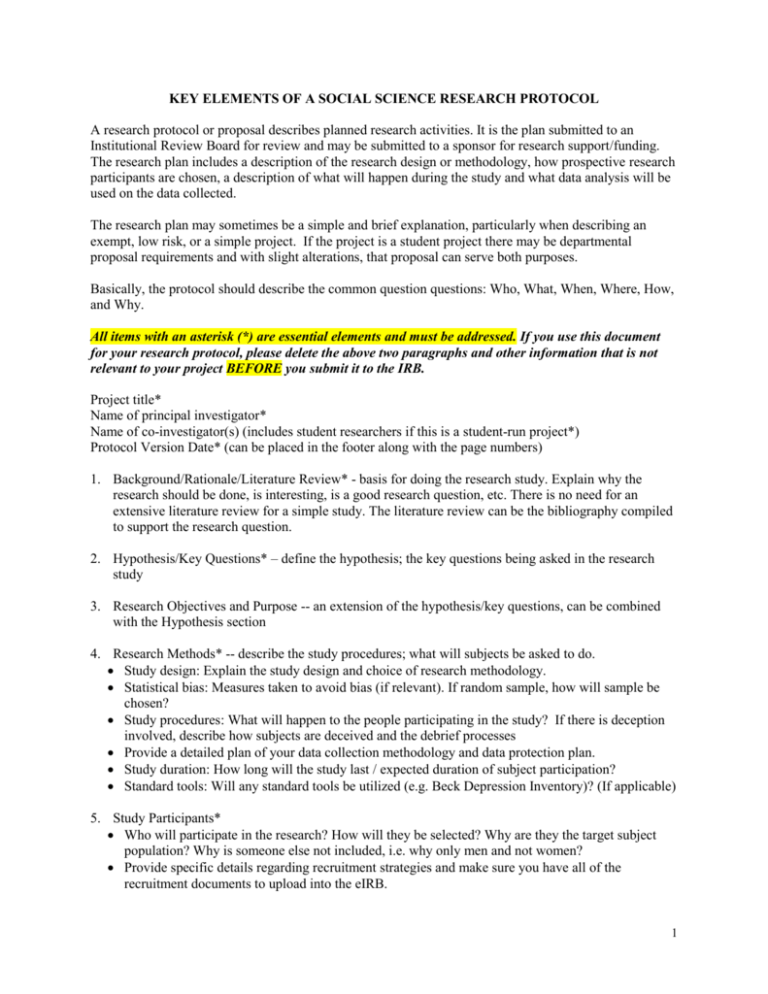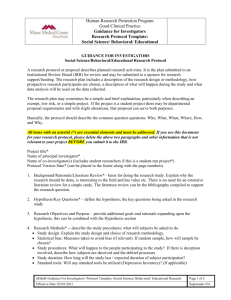Social Behavioral Research Protocol
advertisement

KEY ELEMENTS OF A SOCIAL SCIENCE RESEARCH PROTOCOL A research protocol or proposal describes planned research activities. It is the plan submitted to an Institutional Review Board for review and may be submitted to a sponsor for research support/funding. The research plan includes a description of the research design or methodology, how prospective research participants are chosen, a description of what will happen during the study and what data analysis will be used on the data collected. The research plan may sometimes be a simple and brief explanation, particularly when describing an exempt, low risk, or a simple project. If the project is a student project there may be departmental proposal requirements and with slight alterations, that proposal can serve both purposes. Basically, the protocol should describe the common question questions: Who, What, When, Where, How, and Why. All items with an asterisk (*) are essential elements and must be addressed. If you use this document for your research protocol, please delete the above two paragraphs and other information that is not relevant to your project BEFORE you submit it to the IRB. Project title* Name of principal investigator* Name of co-investigator(s) (includes student researchers if this is a student-run project*) Protocol Version Date* (can be placed in the footer along with the page numbers) 1. Background/Rationale/Literature Review* - basis for doing the research study. Explain why the research should be done, is interesting, is a good research question, etc. There is no need for an extensive literature review for a simple study. The literature review can be the bibliography compiled to support the research question. 2. Hypothesis/Key Questions* – define the hypothesis; the key questions being asked in the research study 3. Research Objectives and Purpose -- an extension of the hypothesis/key questions, can be combined with the Hypothesis section 4. Research Methods* -- describe the study procedures; what will subjects be asked to do. Study design: Explain the study design and choice of research methodology. Statistical bias: Measures taken to avoid bias (if relevant). If random sample, how will sample be chosen? Study procedures: What will happen to the people participating in the study? If there is deception involved, describe how subjects are deceived and the debrief processes Provide a detailed plan of your data collection methodology and data protection plan. Study duration: How long will the study last / expected duration of subject participation? Standard tools: Will any standard tools be utilized (e.g. Beck Depression Inventory)? (If applicable) 5. Study Participants* Who will participate in the research? How will they be selected? Why are they the target subject population? Why is someone else not included, i.e. why only men and not women? Provide specific details regarding recruitment strategies and make sure you have all of the recruitment documents to upload into the eIRB. 1 Provide detailed explanation of the consent process. Number of subjects to be enrolled (if there is more than one subject group, please provide the enrollment break-down for each group). If you are including any vulnerable populations (children, pregnant women, prisoners, mentally ill, mentally challenged, or where literacy is a concern) in your project, state age range, gender if appropriate why this is important and what the benefits are to the specified participants. How will research participants be recruited? Describe the consenting procedures – who will obtain consent? How will it be done? Where will it be done? Sampling: (If applicable) explain how sampling will occur? Selection and withdrawal of subjects (If applicable) 6. Statistical Analysis (only if applicable) Statistical methods including interim analysis if appropriate Rationale for choice of sample size (power calculation and justification) Level of significance to be used Criteria for terminating the study Procedures for reporting deviations from the original plan 7. Anticipated Results and Potential Problems* – Explain what you hope to find out; explain any problems you think you might encounter and suggest solutions. In particular, the IRB is interested in problems that may affect risk level, subject’s willingness to participate, feasibility of doing the research, etc. 2











